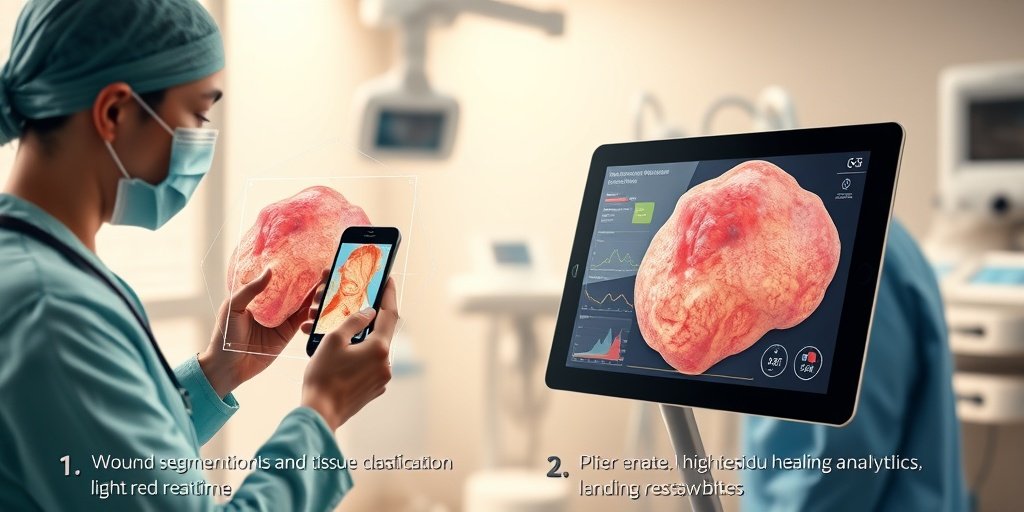⚡ Quick Summary
This study developed an AI-powered wound assessment tool integrated into a mobile application to assist healthcare professionals in diagnosing and managing chronic wounds. The tool demonstrated impressive performance metrics, including a DICE score of 92% for wound segmentation, highlighting its potential to enhance clinical decision-making and reduce healthcare costs.
🔍 Key Details
- 📊 Dataset: Approximately 4,000 wound images collected from three healthcare institutions in Western Switzerland.
- 🧩 Features used: High-resolution images, short videos, 3D scans, and structured clinical metadata.
- ⚙️ Technology: Deep learning models, specifically the Deeplabv3 + architecture with a ResNet50 backbone.
- 🏆 Performance: Wound segmentation achieved a DICE score of 92% and an Intersection-over-Union (IOU) score of 85%.
🔑 Key Takeaways
- 💡 AI integration in wound assessment can significantly improve diagnostic precision.
- 📊 The dual data collection approach ensured both image standardization and real-world variability.
- 🏥 Real-time inference was achieved with an average processing time of 0.3 seconds.
- 🌍 The study included a diverse range of wound types, anatomical locations, and skin tones.
- 🤖 Challenges remain in tissue classification, particularly for fibrin and necrosis.
- 📈 The tool has the potential to reduce wound-related healthcare costs and improve patient outcomes.
- 🗂️ Data collection methods included both retrospective extraction and prospective collection.
- 🔍 The study was conducted across three healthcare institutions in Western Switzerland.

📚 Background
Chronic wounds (CWs) pose a significant challenge in healthcare, characterized by prolonged healing times and complex management. The inadequate assessment of wounds by healthcare professionals, often due to limited training and high clinical workloads, can lead to suboptimal treatment and increased risk of complications. This study aims to address these issues by leveraging artificial intelligence to enhance wound assessment and management.
🗒️ Study
Conducted as a multicenter observational study, researchers compiled a hybrid dataset of approximately 4,000 wound images from three healthcare institutions in Western Switzerland. The study utilized both retrospective extraction from clinical records and prospective collection through a standardized mobile application, ensuring a comprehensive dataset for training and validating deep learning models.
📈 Results
The AI-based wound segmentation model achieved a remarkable DICE score of 92% and an IOU score of 85%. Tissue classification yielded a preliminary mean DICE score of 78%, although accuracy varied across different tissue types. The models were optimized for mobile implementation, achieving real-time inference with minimal performance reduction, showcasing the tool’s practicality in clinical settings.
🌍 Impact and Implications
The development of this AI-driven digital tool represents a significant advancement in clinical wound assessment and education. By integrating robust datasets and AI models, the tool has the potential to improve diagnostic precision, support personalized care, and ultimately reduce wound-related healthcare costs. This innovation could transform wound care practices and enhance clinical training for healthcare professionals.
🔮 Conclusion
This study highlights the transformative potential of AI in wound care, laying the groundwork for a digital tool that can assist healthcare professionals in making informed clinical decisions. While challenges remain, particularly in tissue classification, the promising results underscore the need for continued research and development in this field. The future of wound management looks bright with the integration of AI technologies!
💬 Your comments
What are your thoughts on the integration of AI in wound assessment? We would love to hear your insights! 💬 Leave your comments below or connect with us on social media:
Developing an AI-powered wound assessment tool: a methodological approach to data collection and model optimization.
Abstract
BACKGROUND: Chronic wounds (CWs) represent a significant and growing challenge in healthcare due to their prolonged healing times, complex management, and associated costs. Inadequate wound assessment by healthcare professionals (HCPs), often due to limited training and high clinical workload, contributes to suboptimal treatment and increased risk of complications. This study aimed to develop an artificial intelligence (AI)-powered wound assessment tool, integrated into a mobile application, to support HCPs in diagnosis, monitoring, and clinical decision-making.
METHODS: A multicenter observational study was conducted across three healthcare institutions in Western Switzerland. Researchers compiled a hybrid dataset of approximately 4,000 wound images through both retrospective extraction from clinical records and prospective collection using a standardized mobile application. The prospective data included high-resolution images, short videos, and 3D scans, along with structured clinical metadata. Retrospective data were anonymized and manually annotated by wound care experts. All images were labeled for wound segmentation and tissue classification to train and validate deep learning models.
RESULTS: The resulting dataset represented a broad spectrum of wound types (acute and chronic), anatomical locations, skin tones, and healing stages. The AI-based wound segmentation model, developed using the Deeplabv3 + architecture with a ResNet50 backbone, achieved a DICE score of 92% and an Intersection-over-Union (IOU) score of 85%. Tissue classification yielded a preliminary mean DICE score of 78%, although accuracy varied across tissue types, especially fibrin and necrosis. The models were optimized for mobile implementation through quantization, achieving real-time inference with an average processing time of 0.3 seconds and only a 0.3% performance reduction. The dual approach to data collection, prospective and retrospective-ensured both image standardization and real-world variability, enhancing the model’s generalizability.
CONCLUSIONS: This study laid the foundation for an AI-driven digital tool to assist clinical wound assessment and education. The integration of robust datasets and AI models demonstrated the potential to improve diagnostic precision, support personalized care, and reduce wound-related healthcare costs. Although challenges remained, particularly in tissue classification, this work highlighted the promise of AI in transforming wound care and advancing clinical training.
TRIAL REGISTRATION: Not applicable.
Author: [‘Stefanelli A’, ‘Zahia S’, ‘Chanel G’, ‘Niri R’, ‘Pichon S’, ‘Probst S’]
Journal: BMC Med Inform Decis Mak
Citation: Stefanelli A, et al. Developing an AI-powered wound assessment tool: a methodological approach to data collection and model optimization. Developing an AI-powered wound assessment tool: a methodological approach to data collection and model optimization. 2025; 25:297. doi: 10.1186/s12911-025-03144-y